
Website owner: James Miller
Electrostatics. Capacitor. Capacitance. Leyden jar. Dielectric coefficient. Permittivity. Molecular theory of induced charges on a dielectric. Effect of an electric field on polar and nonpolar molecules. Dielectric strength. Energy of a charged capacitor. Capacitors in series and in parallel.
Capacitor. A device that can be used to store electrical energy much as a stressed spring can store mechanical energy or a water tower can store water.

Operation of a capacitor. Let us connect a electroscope to a metal plate, as shown in Fig. 1 (a), and place a charge on the plate. As we increase the charge, the leaves of the electroscope will diverge more and more widely, and the potential of the plate will increase in proportion to the charge (the potential of any charged plate must be proportional to the amount of charge on the plate). At some point the plate will reach the point where the electrons will leak to the air as rapidly as they are supplied and the plate will be at capacity. Let us now bring a second plate, plate B, which is grounded (connected to the ground), close to it as shown in Fig. 1 (b). As we bring plate B close to it, the leaves of the electroscope start to fall together. The closer we bring plate B, the further the leaves fall. As the leaves fall, the potential on plate A falls also, and the plate’s capacity for holding charge increases. We find we can now add a lot more charge to the plate before it reaches capacity.
What happened here? As we brought plate B close to plate A, the amount of charge on plate A remained the same. Why did the leaves on the electroscope fall? Answer: When plate B was brought opposite to plate A, it became charged by induction. Its electrons were repelled to the far side of the plate and away to the earth through the ground wire. The unbalanced positive charges remaining on plate B acted to “bind” the electrons on plate A, neutralize them, and reduce its potential. With the presence of the unbalanced positive charges on plate B, it takes less work to place the same negative charge on plate A which, reduces its potential.
A combination of conducting plates separated by insulators is known as a capacitor, or condenser. In our experiment, the air space between the plates acted as the insulator. If we were to put a thin sheet of glass between the two metal plates, the leaves of the electroscope would fall appreciably, since glass is a better insulator than air. There are many insulators that are used between the plates of capacitors. Mica is one of the best. The amount of charge that a capacitor will hold depends on the area of the plates, the distance between the plates and the insulator (or dielectric) between the plates. In general a capacitor’s capacity for holding charge increases with the area of the plates and increases as the distance between the plates decreases.
Capacitance. The capacitance of a capacitor is a number representing a measure of the capacitor’s storage capability. It is a constant for a given capacitor. For example, the capacitance of a parallel plate capacitor (the most common type of capacitor and the type we considered in the above experiment) is given by the formula
![]()
where
A = area of the plates (m2)
d = distance between the plates (m)
K = dielectric constant for the dielectric between the plates
ε0 = 8.85×10-12 coul2/nt-m2
C = capacitance (farads)
Def. Capacitance. The capacitance C of a capacitor is defined as the ratio of the charge Q on either plate of the capacitor to the potential difference Vab between the plates i.e.

Consequently, the capacitance C of a capacitor can be viewed as a measure of the amount of charge Q that the capacitor can hold per volt of potential difference between the plates. Thus, at a potential difference of one volt, the capacitor will hold C coulombs of charge, at a potential difference of two volts, it will hold 2C coulombs, etc.
If one were to apply a quantity of charge Q to plate A of the capacitor in Fig. 1 above, the electric potential VAB would increase to Q/C in accordance with equation 2). On the other hand, if one were to apply a potential difference VAB to plates A and B by connecting them to a battery, the quantity of charge Q that would be loaded onto plate A would be CVAB in accordance with equation 2).
The total amount of charge that a capacitor will hold depends on the amount of potential difference between its plates that the capacitor can withstand before breakdown of the dielectric between the plates occurs.
Units of capacitance. In the MKS system, the unit of capacitance is the farad, abbreviated f, named in honor of Michael Faraday. The capacitance of a capacitor is thus one farad when a charge of one coulomb results in a potential difference of one volt between the plates. One farad is an extremely large unit of capacitance. Because the farad is such a large unit, the microfarad is more often used..

1 μf = 1 microfarad = 10-6 f
1μμf = 1 micromicrofarad (or 1 picofarad) = 10-12 f
Leyden jar. The Leyden jar is an early capacitor that was invented independently by a German cleric Ewald Georg von Kleist and by Pieter van Musschenbroek of Leyden, Holland around 1745. It is important because it was used in many of the early experiments in electricity, including experiments performed by Benjamin Franklin. It consists of a glass jar coated with metal foil about halfway up on both inside and outside. A brass ball and rod passing down through an insulating top is electrically connected to the inner metal foil by a metal chain as shown in Fig. 2. The jars were also filled half full of water. To charge a Leyden jar, the brass knob is connected to one terminal of a static charge generator and the outer coating is grounded, as by holding the jar in your hand.

Types of capacitors. Capacitors find wide application in all kinds of electronic circuits and each application has its own requirements. There are a number of different types of capacitors with some suitable for one application and others for another. Capacitors having a fixed capacity are made in several ways. Mica capacitors consist of small metal plates, separated by thin sheets of mica. See Fig. 3. They are typically encased in an insulating material like Bakelite. Some inexpensive capacitors consist of two strips of metal foil, separated by wax paper, rolled into a roll, and coated with wax or encased in a can. In electrolytic capacitors one plate is aluminum foil and the other plate is a borax paste electrolyte. The dielectric consists of a thin film of aluminum oxide and oxygen that forms on the aluminum through a chemical reaction.
Variable capacitors such as the one shown in Fig. 4 are used in radio receivers. They are used to tune to a particular station. The capacitance is varied by rotating the movable plates (rotor plates) M shown in the figure. These movable plates are enmeshed between a set of stationary plates (stator plates) S and rotating the rotor plates varies the area of overlap. The dielectric is air.

Dielectric coefficient. In Fig. 5 (a) is pictured a parallel plate capacitor connected to an electroscope in which the space between the plates is a vacuum. Let us assume that the plates of the capacitor have been given an equal and opposite charge Q and let us measure the potential difference VAB between the plates, obtaining a value of
VAB = Vv .
Let us now place a dielectric that we will call dielectric X between the plates of the capacitor and again measure the potential difference between the plates, obtaining a value of

VAB = Vx .
When the dielectric is placed between the plates, the leaves of the electroscope will fall appreciably, and the value Vx will be less than the value Vv.
The capacitance of the capacitor with a vacuum between the plates is given by
3) Cv = Q/Vv
and capacitance of the capacitor with dielectric X between the plates is given by
4) Cx = Q/Vx
Since Vx < Vv , we see from 3) and 4) that Cx is greater than Cv.
The dielectric coefficient KX of dielectric X is given by

Dielectric |
Dielectric constant (typical value) |
Air |
1 |
Paper (oiled) |
2 |
Paraffin |
2.25 |
Polyethylene |
2.3 |
Polystyrene |
2.5 |
Hard rubber |
2.8 |
Mica |
6 |
Glass |
8 |
Table 1
Since Cx is always greater than Cv, the dielectric coefficient of all dielectrics is always greater than unity. Rearranging 5), we have the following:
The capacitance Cx of any capacitor with a dialectic X between the plates is given by the formula
6) Cx = Kx Cv
where Kx is the dielectric constant of dielectric X and Cv is the capacitance of the capacitor with a vacuum between the plates.
Dielectric constants for various dielectrics are shown in Table 1.
Permittivity. With a vacuum (or air) between its plates, the electric field intensity Ev in the region between the plates of a parallel plate capacitor is

where d is the distance between the plates and σ is the charge density (charge per unit area) on the plates. The observed reduction in potential difference, when a dielectric is inserted between its plates, implies a reduction in the electric field intensity. This, in turn, implies a reduction in the charge per unit area. Since no charge has leaked off the plates, such a reduction has led to the idea that induced charges are created on the dielectric surface that neutralize charges on the plates in the manner shown in Fig. 6. In other words, the dielectric surface next to the positive plate must have an induced negative charge and the surface next to the negative plate must have an induced positive charge of the same magnitude. If σi is the charge density (charge per unit area) of the induced charge on the surfaces of dielectric X, the electric field intensity in the dielectric is


Now

Thus

Substituting 10) into 8) we get

The product Kxε0 is called the permittivity of dielectric X and is represented by εx.
12) εx = Kxε0
The electric field intensity within the dielectric is then

In addition,

and the capacitance Cx of a parallel plate capacitor with a dielectric X between the plates is therefore
![]()
In empty space, where Kx = 1, εx = ε0. Thus we can regard ε0 as the “permittivity of empty space” or the “permittivity of a vacuum”.
Molecular theory of induced charges on a dielectric. When a conductor is placed in an electric field, the free electrons are displaced by the force of the field and redistribute themselves over the surface of the conductor. However, a dielectric contains no free electrons. How, then, is it possible for an induced charge to appear on the surfaces of a dielectric when it is placed in the electric field between the plates of a charged capacitor?
Polar and nonpolar molecules. Electrons are not always shared equally between two bonding atoms. One atom may exert more force on the electron cloud than the other, pulling the cloud toward itself. This kind of thing can lead to a situation where the center of charge (i.e. “center of gravity” with respect to charge) of the positive charges in a molecule does not coincide with the center of charge of the negative charges. When the center of charge of the positive charges is separated from the center of charge of the negative charges by some distance d, an electric dipole is formed. A polar molecule is one in which the center of charge of the positive charges is separated from the center of charge of the negative charges by some distance d. A nonpolar molecule is one in which the center of charge of the positive charges coincides with the center of charge of the negative charges. Symmetrical molecules like H2, N2, and O2 are nonpolar. NaCl is highly polar. In general, molecules are either nonpolar or they possess varying degrees of polarity.
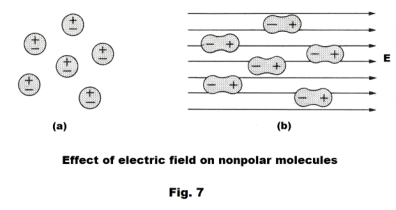
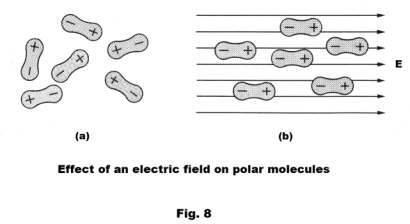
Effect of an electric field on nonpolar molecules. An electric field has a distending effect on nonpolar molecules, pulling on the negative charges and pushing the positive charges in the molecule. Under its influence, the center of charge of the positive charges becomes separated from the center of charge of the negative charges resulting in what is called an induced dipole. The molecules are said to have become polarized by the field. Fig. 7 (a) shows nonpolar molecules in the absence of an electric field and Fig. 7 (b) shows what happens to them in the presence of an electric field. When the field exerts its distending force on the charges, restoring forces come into play, attempting to pull the charges back into their normal positions. The positive and negative charges of the molecule separate until the restoring force is equal and opposite to the force exerted by the field. The restoring forces vary in magnitude, of course, from one kind of molecule to another, resulting in differences in the displacement produced by a given field.
Effect of an electric field on polar molecules. In the absence of an electric field, polar molecules (or permanent dipoles, as they are called), are oriented in random directions in a substance as shown in Fig. 8 (a). The effect of an electric field is to align them, to some degree, in the direction of the field, as is shown in Fig. 8 (b). The stronger the field, the more the alignment.
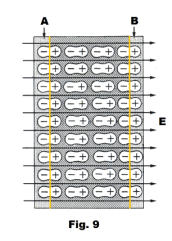
Whether the molecules of a substance are polar or nonpolar, the net effect of an external electric field is that shown in Fig. 9. The column of negative charges A and the column of positive charges B in the figure represent two extremely thin surface areas on the substance which contain excess charge. It is these layers that give rise to the apparent induced charge on the faces of a dielectric in a capacitor. The charges are not free. Each is bound by a molecule lying in or near the surface. In the interior of the substance the net charge per unit volume is zero.
Dielectric material |
Dielectric strength (kv/cm to puncture) |
Air |
30 |
Oil |
75 |
Paraffin |
350 |
Paper (oiled) |
400 |
Mica |
500 |
Glass |
1000 |
Table 2
Def. Dielectric strength. The maximum potential gradient (electric field strength) that a material can withstand without rupture.
International Dictionary of Applied Mathematics
Dielectric strengths of various substances are shown in Table 2.
Energy of a charged capacitor. The energy W stored in a charged capacitor is given by

or, equivalently, by
![]()
where Q is the charge on the capacitor, VAB is the potential difference between the plates, and C is the capacitance of the capacitor. Proof
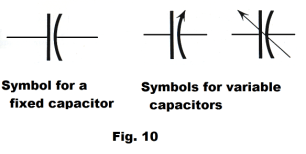
W is in joules if Q is in coulombs, VAB is in volts, and C is in farads.
Symbols used to denote capacitors. The symbols used in wiring diagrams to denote capacitors are shown in Fig. 10.
Capacitors in series and in parallel. In circuit applications several
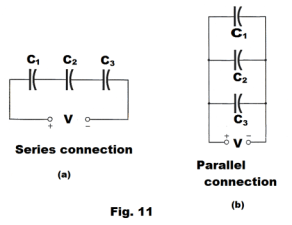
capacitors are often connected in various ways. The two simplest connections are the series connection and the parallel connection. See Fig. 11. When we are faced with such combinations we often want to know the effective capacitance of the combination. In other words, we want to know the capacitance of that single capacitor that has the same effect in the circuit as the combination.
Theorem 1. Capacitors connected in series. The equivalent capacitance CE of n capacitors C1, C2, ... , Cn connected in series is given by

where C1, C2, ... , Cn are the capacitances of the capacitors.
Theorem 2. Capacitors connected in parallel. The equivalent capacitance CE of n capacitors C1, C2, ... , Cn connected in parallel is
19) Cn = C1 + C2 + ... + Cn
where C1, C2, ... , Cn are the capacitances of the capacitors.
References
1. Dull, Metcalfe, Williams. Modern Physics.
2. Sears, Zemansky. University Physics
3. Semat, Katz. Physics.
Jesus Christ and His Teachings
Way of enlightenment, wisdom, and understanding
America, a corrupt, depraved, shameless country
On integrity and the lack of it
The test of a person's Christianity is what he is
Ninety five percent of the problems that most people have come from personal foolishness
Liberalism, socialism and the modern welfare state
The desire to harm, a motivation for conduct
On Self-sufficient Country Living, Homesteading
Topically Arranged Proverbs, Precepts, Quotations. Common Sayings. Poor Richard's Almanac.
Theory on the Formation of Character
People are like radio tuners --- they pick out and listen to one wavelength and ignore the rest
Cause of Character Traits --- According to Aristotle
We are what we eat --- living under the discipline of a diet
Avoiding problems and trouble in life
Role of habit in formation of character
Personal attributes of the true Christian
What determines a person's character?
Love of God and love of virtue are closely united
Intellectual disparities among people and the power in good habits
Tools of Satan. Tactics and Tricks used by the Devil.
The Natural Way -- The Unnatural Way
Wisdom, Reason and Virtue are closely related
Knowledge is one thing, wisdom is another
My views on Christianity in America
The most important thing in life is understanding
We are all examples --- for good or for bad
Television --- spiritual poison
The Prime Mover that decides "What We Are"
Where do our outlooks, attitudes and values come from?
Sin is serious business. The punishment for it is real. Hell is real.
Self-imposed discipline and regimentation
Achieving happiness in life --- a matter of the right strategies
Self-control, self-restraint, self-discipline basic to so much in life